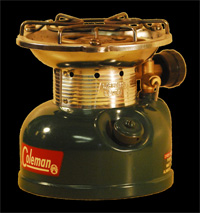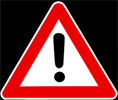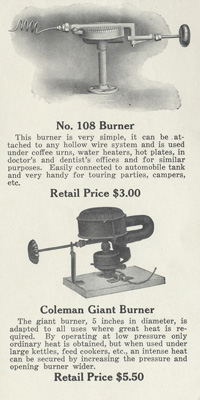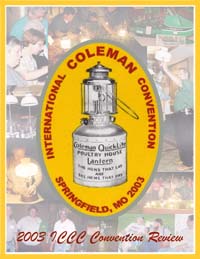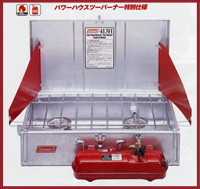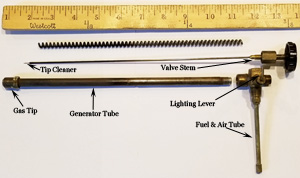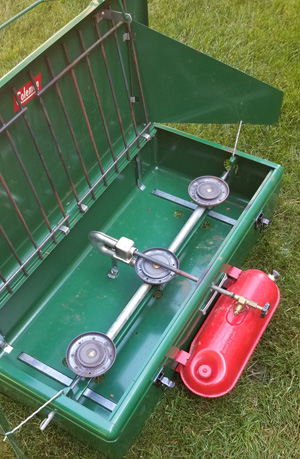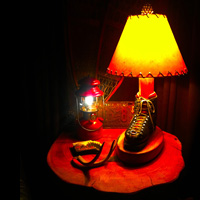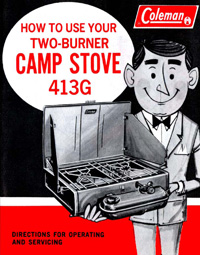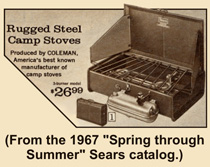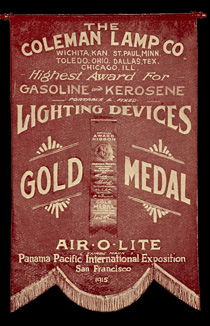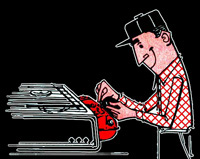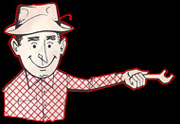 How Pressure Appliances Work
How Pressure Appliances Work
Part IV: Making Fire
The basic principles powering Coleman® lamps and lanterns also apply to Coleman® stoves and burners. Aside from the few differences that we'll cover, they operate in pretty much the same way. The primary difference is their physical size, and that lanterns produce light and stoves produce heat.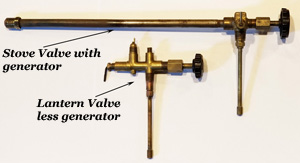
This discussion will focus on two and three burner stoves. These iconic "suitcase" stoves are very common and have been around since the mid 1920s. Single burner stoves, like Model 500 and 502, operate in the same manner but are significantly smaller. Coleman® also made full-sized kitchen stoves, trailer stoves, alcohol-burning marine stoves and a variety of burners for the war efforts in the 1940s and 1950s. They are all pressure devices and operate basically the same way.
The photo above shows an exploded view of a stove fuel valve and generator. You'll remember that the mantle is responsible for heating a lantern generator. This task is performed by the master burner on a stove. It takes a bit longer for a stove generator to get hot, which means it takes longer for the stove to burn properly.
Notice that the generator's tip cleaner is attached to the valve stem. The lantern's tip cleaner was operated by a lever and an eccentric block, but on a stove it moves with the on/off function of the valve stem. The counterclockwise turn of the valve stem extracts the pointed tip cleaner from the gas tip. The opposite happens when you close the valve—the tip cleaner reinserts itself in the gas tip to clean it.
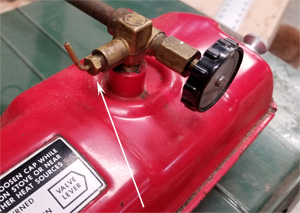 The next difference is how the fuel and air tube is manipulated. You'll remember that the lantern fuel and air tube moved with the movement of the valve stem. The stove fuel and air tube is controlled by a small lever on the fuel valve called the lighting lever. The metering rod attaches directly to the lever and is called the block and needle.
The next difference is how the fuel and air tube is manipulated. You'll remember that the lantern fuel and air tube moved with the movement of the valve stem. The stove fuel and air tube is controlled by a small lever on the fuel valve called the lighting lever. The metering rod attaches directly to the lever and is called the block and needle.
Instructions for starting a Coleman® stove include "up to light, down to burn".  When the lever is up, the fuel and air tube is sending a lean mixture to the fuel valve. The instructions then say to turn the lever down after one minute. This opens the fuel intake port on the fuel and air tube.
When the lever is up, the fuel and air tube is sending a lean mixture to the fuel valve. The instructions then say to turn the lever down after one minute. This opens the fuel intake port on the fuel and air tube.
Please don't get confused by the levers! The lever on a lantern is called the tip cleaner stem and it controls the generator gas tip. The lever on a stove is called the lighting lever and it controls the fuel & air tube metering rod.
The stove's burner assembly, or manifold, is significantly larger than that of a lantern. The photo shows a 426B three-burner stove and the distance between the burners is over 9 inches.
This is a safety issue because many a stove has been engulfed in flames because of this manifold. It takes one insect nest inside for you to have a big problem. When you prepare to light the stove and start to open the valve, fuel is blocked by the nest and it will pool inside the manifold. You keep your matches lit above the burner and wait while more raw gasoline collects. When your flame finally finds the fuel, a huge fireball results.
As with the lantern, hot vapor shoots from the generator where it immediately encounters an open hollow tube with a 180° bend in it. At the U-tube, vapor is mixed with fresh air and its velocity is increased by a venturi. The fast-moving mixture exits the U-tube and is fed into small box called the burner box. The burner box holds the parts required to make an intensely hot flame. On a two or three burner stove, this box is considered the "master" burner.
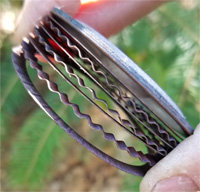
Sitting on top of the burner box is a burner bowl, and a series of alternating flat and corrugated rings called burner rings, shown to the right. The burner rings are positioned in a manner where they create multiple levels of very small holes in a circle. On top of the burner rings is the burner cap, and the entire assembly is held together by the burner screw.
A two-burner stove has a pipe that connects a second burner box, which we call the auxiliary burner. On a three-burner stove, of course, there are two auxiliary burners. The auxiliary burner(s) can be turned on or off independently of the Master Burner by a large butterfly handle on the side of the stove case.
Pressure stoves use the Bunsen effect to create a hot flame that produces very little light. Coleman® actually called the master burner the "Bunsen Assembly" 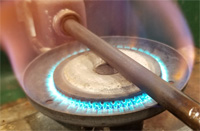 back in the 1940s. When the proper mixture of fuel and air is applied, it produces a very hot blue flame in a circular pattern, which is exactly what we want from our stove or burner.
back in the 1940s. When the proper mixture of fuel and air is applied, it produces a very hot blue flame in a circular pattern, which is exactly what we want from our stove or burner.
I hope this tutorial gave you an understanding of pressure devices. They have amazed and baffled millions of people over that past hundred years, with good reason. But now you see that they're not overly complicated which is one reason why so many are still working just fine today.
![]() Part I: Creating and maintaining pressure
Part I: Creating and maintaining pressure
![]() Part II: Heating the fuel to create a gas vapor
Part II: Heating the fuel to create a gas vapor
![]() Part III: Igniting the vapor to luminesce the mantle
Part III: Igniting the vapor to luminesce the mantle


